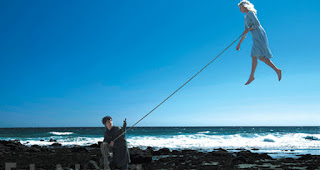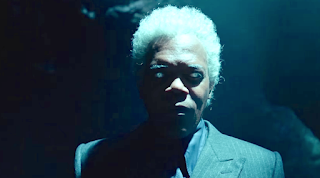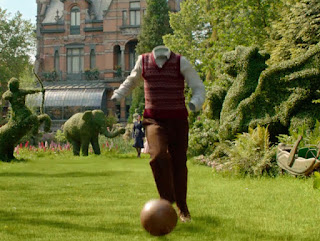Although my favorite Tim Burton-directed film remains Big Fish, Miss Peregrine’s Home for Peculiar Children is particularly appealing…and worthwhile entertainment. It is a visual delight, which is no surprise due to Burton’s unique genius, ranking alongside 1990’s Edward Scissorhands in terms of bizarre story as well as empathetic characters. In Scissorhands there was one otherworldly being; in Peregrine’s there are multiple strange ones. And I mean very strange.
 Based upon Ransom Rigg’s 2011 novel of the same title, Miss Peregrine’s Home for Peculiar Children has been aptly described as a “dark fantasy film.” The story involves time travel, relationships, wildly gifted characters, and (supplying the film’s central conflict) evil forces. It has a PG-13 rating that should be called “a strong PG-13” due to violent and gross sequences that include eyeball eating. How’s that for a teaser?
Based upon Ransom Rigg’s 2011 novel of the same title, Miss Peregrine’s Home for Peculiar Children has been aptly described as a “dark fantasy film.” The story involves time travel, relationships, wildly gifted characters, and (supplying the film’s central conflict) evil forces. It has a PG-13 rating that should be called “a strong PG-13” due to violent and gross sequences that include eyeball eating. How’s that for a teaser?Like the book, Jane Goldman’s screenplay centers on 16 year-old Jake Portman (Asa Butterfield) whose close relationship with his storytelling grandfather Abraham Portman (Terence Stamp) prompts Jake’s journey to a remote island. There he finds the basis for his grandfather’s fairytales. All those childhood fantasies about a home for “peculiar” children are actually true, shockingly so.
 The children, aka “Peculiars,” are housed in an old mansion on the island, and supervised by protective headmistress Miss Alma LeFay Peregrine (Eva Green). Her wards are children ranging in age from 7-16. Each has specific abilities.
The children, aka “Peculiars,” are housed in an old mansion on the island, and supervised by protective headmistress Miss Alma LeFay Peregrine (Eva Green). Her wards are children ranging in age from 7-16. Each has specific abilities. For example, Ella Purnell portrays Emma Bloom, a Peculiar who wears leaded boots to prevent her from floating away. Emma can also control weather and create giant liquid oxygen bubbles. That’s a handy plus for underwater activity.
For example, Ella Purnell portrays Emma Bloom, a Peculiar who wears leaded boots to prevent her from floating away. Emma can also control weather and create giant liquid oxygen bubbles. That’s a handy plus for underwater activity. __________
Ella Purnell listens to directions from Tim Burton during filming.
__________
Another Peculiar is Millard Nullings, an invisible boy. Then there is the girl Claire with an extra mouth in back of her head…and the large mouth is filled with razor sharp teeth. Yum. Not to mention the boy Hugh whose stomach is swarming with bees, and the preteen Fiona who controls plant growth. Super strength, pyrokinesis, and death resurrection are possessed by the other kiddos. Even Miss Peregrine has a couple of special abilities: time control + transforming into a falcon.
 The Peregrine “family” is in constant fear of being annihilated by the Nazis, the Wights, and the Hollows—the latter two led by Samuel L. Jackson’s determined Mr. Barron. To make matters worse for Peregrine, the literally empty-eyed Barron can transform himself into any other being.
The Peregrine “family” is in constant fear of being annihilated by the Nazis, the Wights, and the Hollows—the latter two led by Samuel L. Jackson’s determined Mr. Barron. To make matters worse for Peregrine, the literally empty-eyed Barron can transform himself into any other being. Nazis? Again, the story involves time travel. So there is shifting from the present to 1943 WWII.
 Besides being overlong (2 hours, 7 minutes) and having a slapdash ending, Miss Peregrine’s Home for Peculiar Children is a sensory treat. Imaginative set design, makeup, sound, and digital effects are superb. See it in 3D if possible.
Besides being overlong (2 hours, 7 minutes) and having a slapdash ending, Miss Peregrine’s Home for Peculiar Children is a sensory treat. Imaginative set design, makeup, sound, and digital effects are superb. See it in 3D if possible. Burton has utilized stop motion photography in previous films, notably The Nightmare Before Christmas (1993), and he effectively uses it again here in a great sequence of skeletons coming alive and even sword fighting. It is obviously a homage to Ray Harryhausen’s skeleton army scene in Jason and the Argonauts (1963).
——————————
GRADE on an A-F Scale: B


